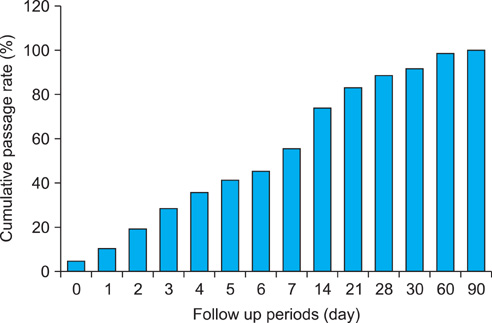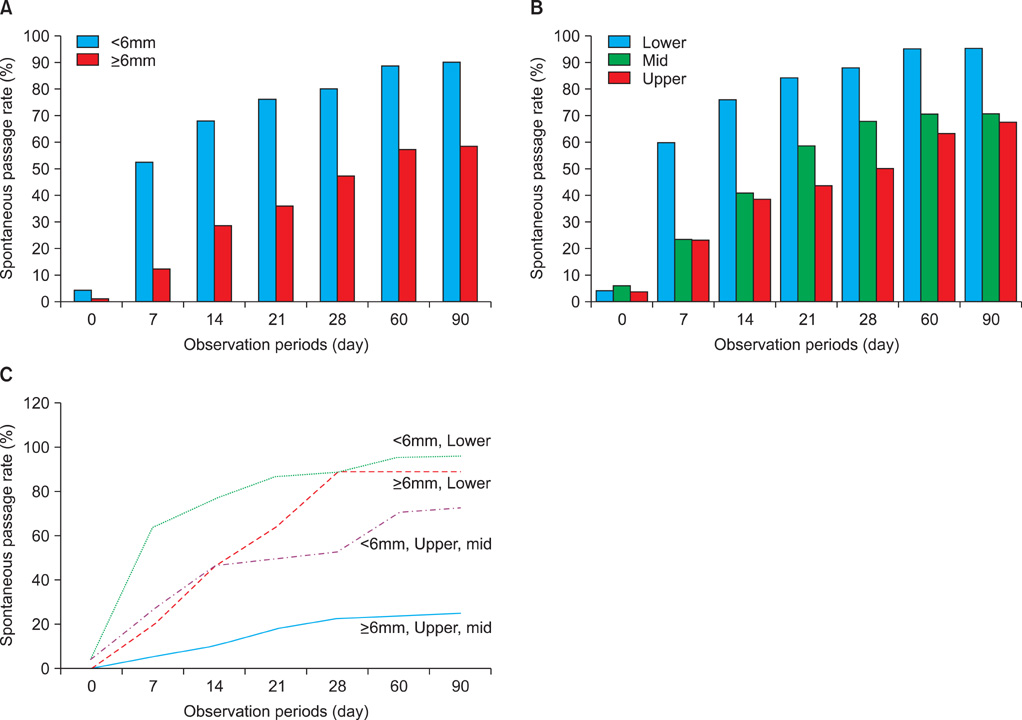Korean J Urol.
2011 Dec;52(12):847-851.
Expectant Management of Ureter Stones: Outcome and Clinical Factors of Spontaneous Passage in a Single Institution's Experience
- Affiliations
-
- 1Department of Urology, Chungbuk National University College of Medicine, Cheongju, Korea. lscuro@chungbuk.ac.kr
Abstract
- PURPOSE
The aim of this study was to evaluate the outcome of ureter stones with expectant management and the clinical factors associated with stone passage in Koreans.
MATERIALS AND METHODS
We reviewed the charts of patients who visited the emergency room or urological office of our institution with acute renal colic between 2001 and 2008. A total of 656 ureter stone formers were enrolled in this study who had decided to be treated by expectant management. Clinical data such as gender, age, size and location of the stone, body mass index, and previous stone history were analyzed to find the factors related to spontaneous passage of ureter stones.
RESULTS
Of the 656 ureter stones, 566 stones (86.3%) were spontaneously expelled. Mean duration of follow-up was 17.5 days (range, 1 to 100 days). Mean time to stone passage was 6.8 days for stones less than 2 mm in size, 12.6 days for stones 2 to 4 mm, 14.8 days for stones 4 to 6 mm, and 21.8 days for stones 6 to 8 mm (p<0.001). The cumulative spontaneous passage rate was 55.3% in 7 days, 73.7% in 14 days, 88.5% in 28 days, and 97.7% in 60 days after the first attack. A total of 90 patients (13.7%) required interventions because of symptom relapse or renal deterioration that was related to the location and size of the stone (each, p<0.001). The more proximal the location and the larger the stone was than 6 mm, the less the chance of spontaneous passage (each, p<0.001).
CONCLUSIONS
Size and location of ureter stones are the most important factors for predicting the spontaneous passage of the stone. If a patient has a distal ureter stone of less than 6 mm in size, it is acceptable for the urologist to observe for spontaneous passage for 2 months.
Keyword
MeSH Terms
Figure
Reference
-
1. Elton TJ, Roth CS, Berquist TH, Silverstein MD. A clinical prediction rule for the diagnosis of ureteral stone in emergency departments. J Gen Intern Med. 1993. 8:57–62.2. Stewart C. Nephrolithiasis. Emerg Med Clin North Am. 1988. 6:617–630.3. Wolf JS Jr. Treatment selection and outcomes: ureter calculi. Urol Clin North Am. 2007. 34:421–430.4. Prina LD, Rancatore E, Secic M, Weber RE. Comparison of stone size and response to analgesic treatment in predicting outcome of patients with renal colic. Eur J Emerg Med. 2002. 9:135–139.5. Kobayashi T, Nishizawa K, Watanabe J, Ogura K. Clinical characteristics of ureteral calculi detected by nonenhanced computerized tomography after unclear results of plain radiography and ultrasonography. J Urol. 2003. 170:799–802.6. Morse RM, Resnick MI. Ureter calculi: natural history and treatment in an era of advanced technology. J Urol. 1991. 145:263–265.7. Hübner WA, Irby P, Stoller ML. Natural history and current concepts for the treatment of small ureteral calculi. Eur Urol. 1993. 24:172–176.8. Segura JW, Preminger GM, Assimos DG, Dretler SP, Kahn RI, Lingeman JE, et al. Ureteral stones Clinical Guidelines Panel summary report on the management of ureteral calculi. The American Urological Association. J Urol. 1997. 158:1915–1921.9. Ueno A, Kawamura T, Ogawa A, Takayasu H. Relation of spontaneous passage of ureteral calculi to size. Urology. 1977. 10:544–546.10. Miller OF, Kane CJ. Time to stone passage for observed ureteral calculi: a guide for patient education. J Urol. 1999. 162:688–690.11. Choo MS, Kim SW, Lee ES, Paick JS, Kim SW. Ureteral calculi: treatment options under advanced technology. Korean J Urol. 1992. 33:666–671.12. Min SK, Shin KY. Treatment options for lower ureteral calculi: expectancy or endourologic manipulations. Korean J Urol. 1995. 36:874–880.13. Park WJ, Kwon JO, Oh TH. The outcome of laparoscopic retroperitoneal ureterolithotomy for the management of upper ureter stones larger than 10 mm: a comparison with rigid ureteroscopic removal of stones with Lithoclast(R). Korean J Urol. 2009. 50:349–354.14. Lee YS, Lee DH, Han WK, Kim HJ, Yang SC, Rha KH. Laparoscopic ureterolithotomy has a role for treating ureteral stones. Korean J Urol. 2006. 47:498–501.15. Jeong BC, Park HK, Byeon SS, Kim HH. Retroperitoneal laparoscopic ureterolithotomy for upper ureter Stones. J Korean Med Sci. 2006. 21:441–444.16. Kim KS, Sul CK, Lim JS. Efficacy of Laparoscopic ureterolithotomy for the upper ureter stone. Korean J Urol. 2008. 49:727–732.17. Kim TH, Jeong BC, Seo SI, Jeon SS, Han DH. Transumbilical laparoendoscopic single-site ureterolithotomy for large impacted ureteral stones: initial experiences. Korean J Urol. 2010. 51:403–408.18. Kang DI, Cho WY, Kim TH, Chung JM, Park J, Yoon JH, et al. Effect of Tamsulosin 0.2 mg on the short-term treatment of urinary stones: multicenter, prospective, randomized study. Korean J Urol. 2009. 50:586–590.19. Kim TH, Oh SY, Moon YT. The effect of Tamsulosin on expulsion of ureter stones after extracorporeal shock wave lithotripsy. Korean J Urol. 2008. 49:1100–1104.20. Yoon WY, Jeong TY, Lee SI, Kim DJ. Effect of Tamsulosin and dichlozid on the expected treatment of ureteral calculi. Korean J Urol. 2009. 50:1213–1218.
- Full Text Links
- Actions
-
Cited
- CITED
-
- Close
- Share
- Similar articles
-
- Spontaneous passage of ureteral stone by conservative treatment
- Clinical Experience of the Lower Ureteral Stones
- Spontaneous passage of ureteral stone by conservative treatment
- Predictors for the Failure of Expectant Management for the Spontaneous Passage of Ureteral Calculi
- Treatment Options for Lower Ureteral Calculi: Expectancy or Endourologic manipulations



